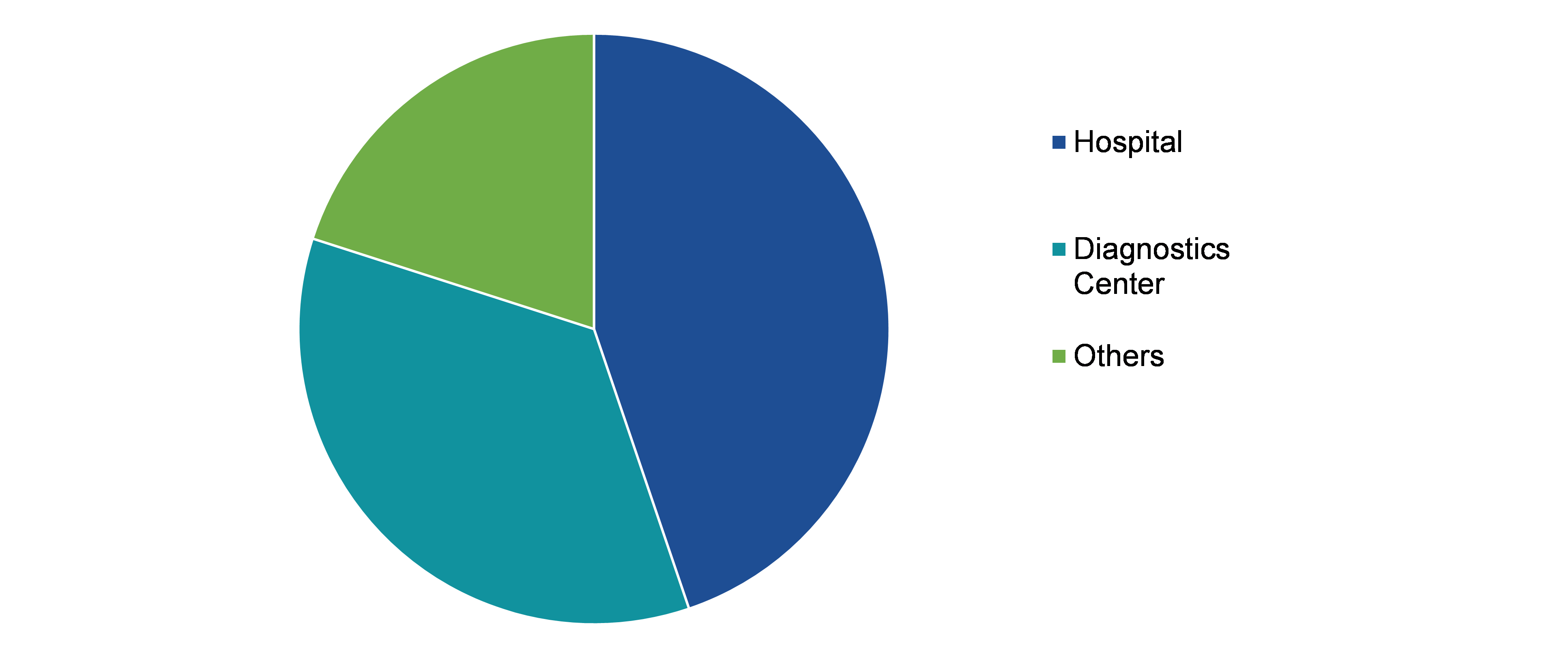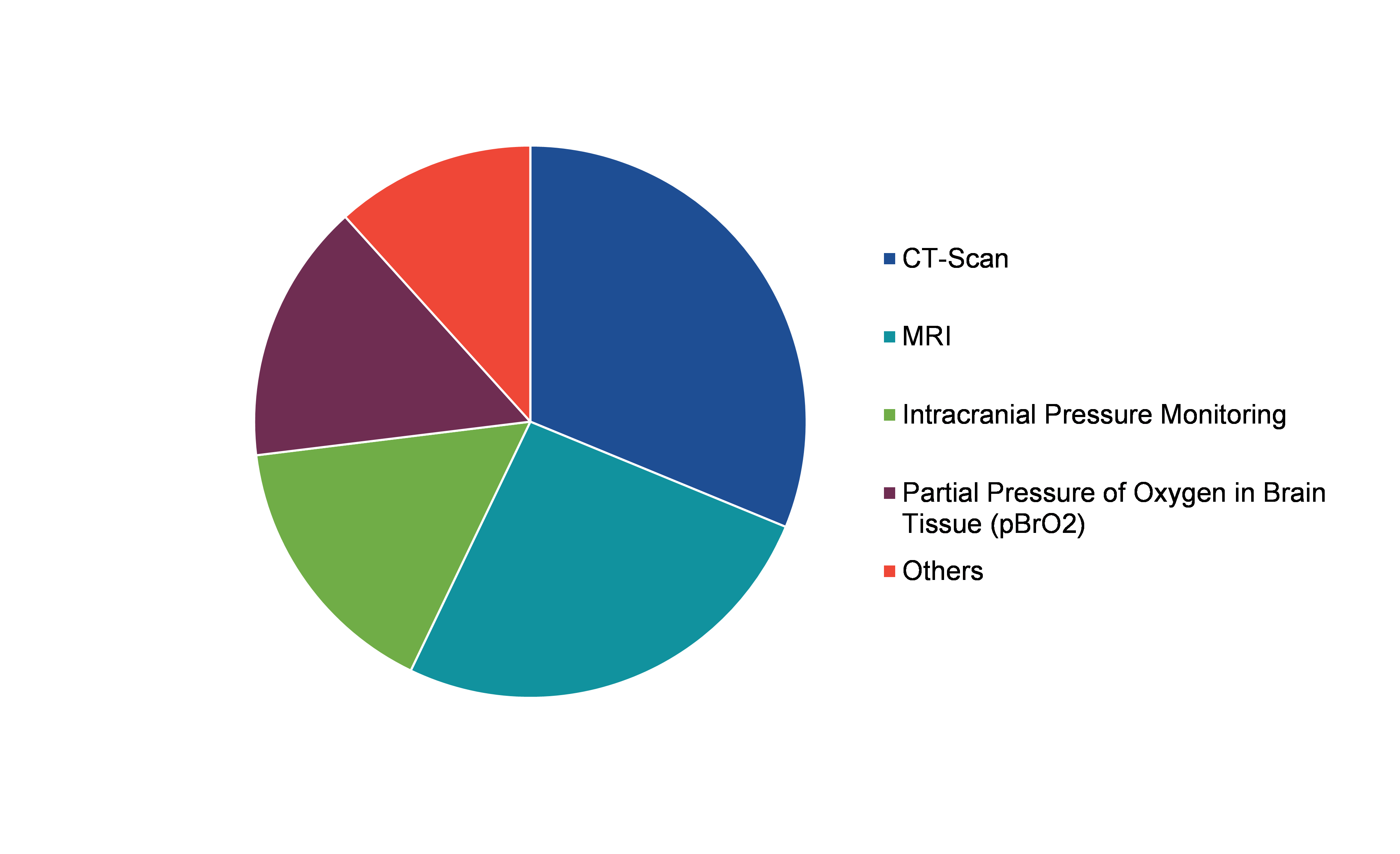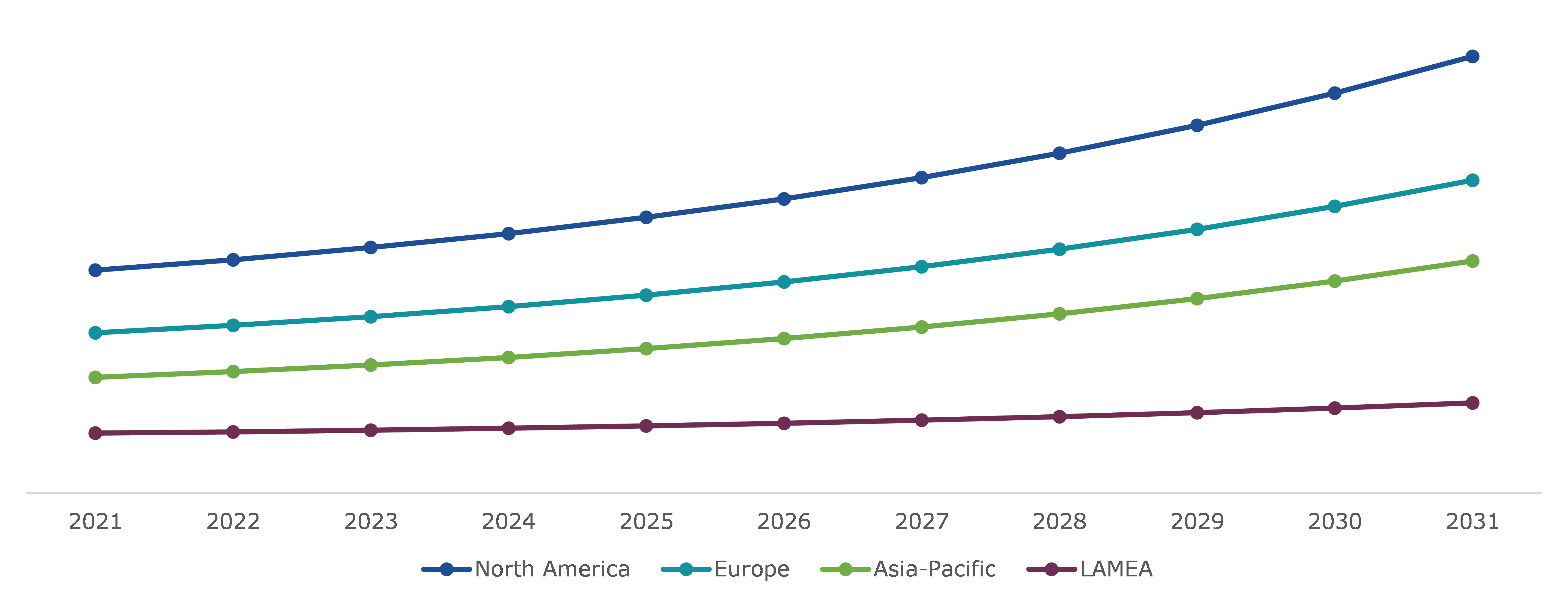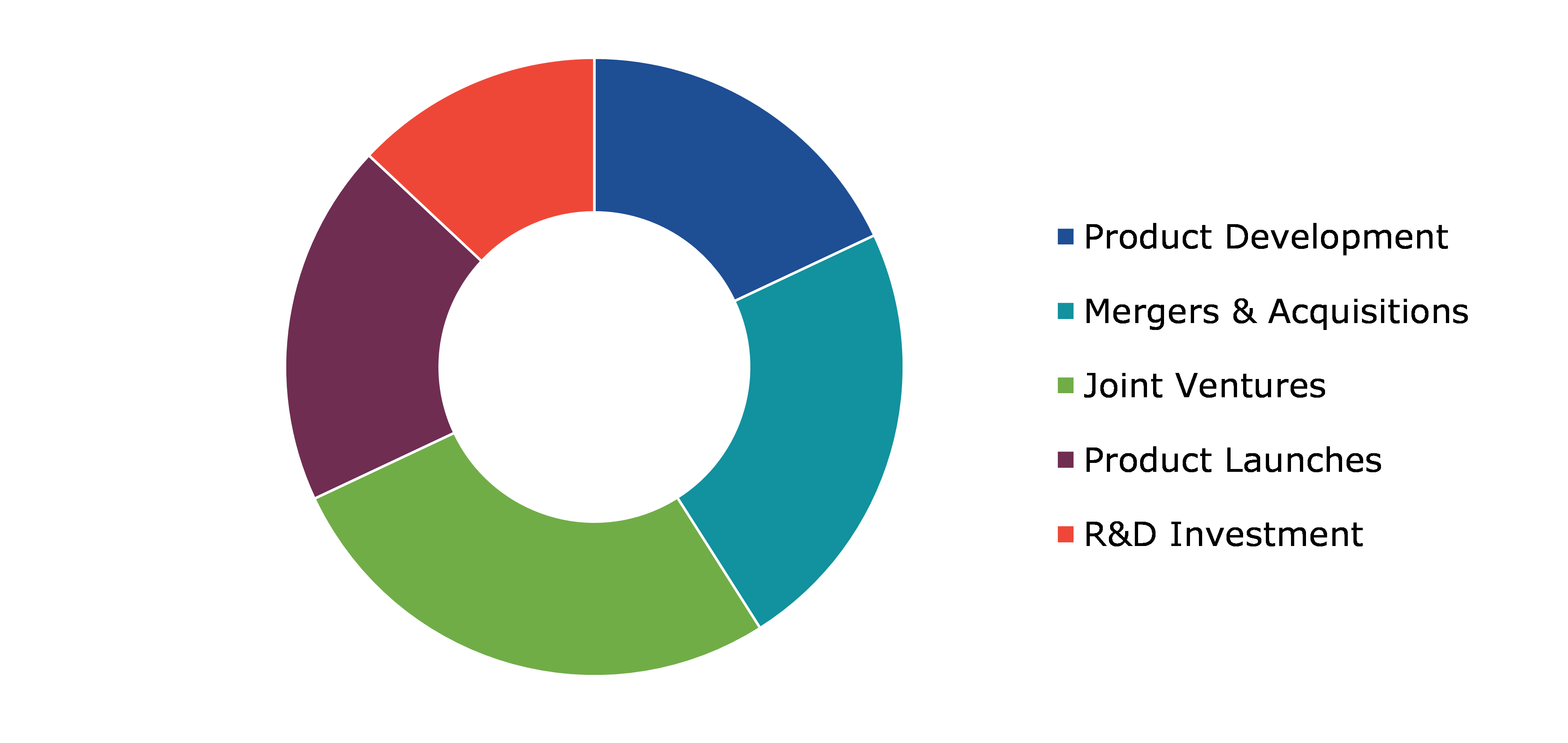Traumatic Brain Injuries Assessment Market Report
RA08590
Traumatic Brain Injuries Assessment Market, by End-user (Hospital, Diagnostics Center, and Others) and Diagnostic Type (CT-Scan, MRI, Electronics, Intracranial Pressure Monitoring, Partial Pressure of Oxygen in Brain Tissue (pBrO2), and Others) Global Opportunity Analysis and Industry Forecast, 2022-2031
Global Traumatic Brain Injuries Assessment Analysis
The global Traumatic Brain Injuries Assessment market size was $9,570 million in 2021 and is predicted to expand at a CAGR of 7.0% by generating a revenue of $18,373.6 million by 2031.
Global Traumatic Brain Injuries Assessment Market Synopsis
The global traumatic brain injuries assessment market trend is one of the rapidly expanding markets. It is predicted to achieve impressive future results due to the rise in cases of brain injuries brought on by accidents, falls, blunt traumas, and other physical damage to the brain, as well as the ongoing investments in the establishment and growth of the market size and share. The need for traumatic brain injury equipment and devices to map any type of brain injury has increased recently, which has led to an expansion of the global market.
The market for the treatment of traumatic brain injuries is growing in various ways across all segments and geographical locations due to growing population and rising per capita incomes, which are increasing consumer demand for highly sophisticated and technologically advanced products &equipment. TBIs are head injuries that occur as a result of a blow, jolt, or piercing head injury. They impair brain function. TBI is linked to a higher incidence of substance abuse, significant depression, anxiety, and unemployment in adults.
The electroencephalogram (EEG) technology, which has proven quite successful in gaining access to the brain activity of unconscious persons and aiding the brain in recovering from all the traumas and shocks following the damage, is specifically used in the treatment of traumatic brain injuries. Several technological developments and advancements are helping patients recover from the effects of any form of brain injury by enhancing their mental health.
Traumatic Brain Injuries Assessment Overview
Traumatic brain injury (TBI), which can be brought on by a blow, bump, or jolt to the head, the head violently slamming against something, or when an object pierces the skull and penetrates the brain tissue, is a disruption in the normal operation of the brain. Treatment for traumatic brain injuries is a therapeutic area developed to address all forms of brain damage and forceful traumas. The treatment is mostly focused on giving patients therapy for minor injuries and retrieving memories that have been lost because of physical compression.
COVID-19 Impact on Global Traumatic Brain Injuries Assessment Market
The global COVID-19 pandemic was announced in March 2020, leading to the mobilization of healthcare resources for high-acuity COVID-19 patients, the cessation of elective surgeries, and directives for people to remain at home. Data suggests that during the pandemic, individuals put off getting treatment for urgent diseases, including heart attack and stroke, but patterns for brain damage are less obvious.
The novel coronavirus or COVID-19 pandemic had a negative effect on the traumatic brain injury treatment industry due to people being restricted to their homes and a lack of new reports of brain injuries caused by car accidents or any sports injuries, which led to staffing shortages, accumulated stock, and other problems for traumatic brain injury treatment companies. Demand for treatment of traumatic brain injuries dramatically decreased as a result of lockdowns in many countries, restrictions on people's freedom of movement, and the fact that many individuals delayed their trips to the doctor's office until an emergency. Many traumatic brain injury treatment businesses were forced to lay off staff, but the market picked up pace as a result of the impending brain injury procedures in the post-lockdown period. Moreover, it is expected that each segment will play a sizable role in the global traumatic brain injuries assessment market growth.
The Advancement in Drug Treatments is a Major Factor Driving the Global Traumatic Brain Injuries Assessment Market Growth
Another significant factor that drives the global market for the treatment of traumatic brain injuries is the rise in health awareness campaigns and programs, which inspire people to take better care of their health and be more aware of the diseases that can be brought on by using certain products. The expansion of medical facilities worldwide and financial commitments from both public and private sectors have also enabled the global traumatic brain injuries assessment market share to expand significantly.
To know more about the global traumatic brain injuries assessment market drivers, get in touch with our analysts here.
Delayed Diagnosis and Low Government Funding in TBI Treatment Restraining the Growth of the Market
A major barrier to the growth of the market is the high cost of treating traumatic brain injuries. This prohibits the majority of patients who lack adequate financial resources from seeking treatment for brain injuries. Also, not many companies and health insurers provide adequate reimbursement facilities to the patients in case of traumatic brain injuries treatment which is further expected to have a stringent growth for global traumatic brain injuries assessment market opportunity.
High Demand for Non-Invasive Technologies, Increase in Sports Injuries, and Rise in TBI Awareness is Expected to Create Tremendous Growth Opportunities
The market study on traumatic brain injury treatments includes information on recent developments, trade laws, production analysis, value chain optimization, market share, and the effects of domestic and localized market competitors. It also examines opportunities for new revenue streams, regulatory changes, strategic market growth analysis, market size, category market expansions, application places& dominance, product approvals, and production. A considerable number of cases of traumatic brain injuries occur each year throughout the world, which is a grave public health concern. The second most common reason for hospitalization for TBI patients is falls, followed by auto accidents. The CDC estimates that 3.5 million Americans currently suffer from a persistent disability due to a TBI. The demand for TBI assessment and management devices is therefore anticipated to increase due to the rise in the number of traffic accidents and injuries.
To know more about global traumatic brain injuries assessment market forecast, get in touch with our analysts here.
Global Traumatic Brain Injuries Assessment Market Share, by End-user
On the basis of end user, the market is divided into hospital, diagnostics center, and others. Among these, the hospital segment accounted for the highest market share during the forecast period.
Global Traumatic Brain Injuries Assessment Market Size, by End-user, 2021
Source: Research Dive Analysis
The hospital segment’s growth is mostly related to an increase in hospitalized brain procedures as well as a rise in the prevalence of TBI patients worldwide. Hospitals are well-equipped with cutting-edge technology that is used by qualified neurologists. This is expected to accelerate the segment's expansion during the forecast period. The other segment, which includes emergency clinics, research institutes, and ambulatory surgical centers (ASCs), is anticipated to grow at the quickest rate. This development can be linked to a number of benefits emergency clinics and ASCs offer over hospitals, including quicker procedure times and same-day discharge.
Global Traumatic Brain Injuries Assessment Market Value, by Diagnostic Type
On the basis of diagnostic type, the market is divided into CT-Scan, MRI, intracranial pressure monitoring, partial pressure of oxygen in brain tissue (pBrO2), and others. Among these, the CT-Scan segment accounted for the highest revenue share in 2021.
Global Traumatic Brain Injuries Assessment Market Growth, by Diagnostic Type, 2021
Source: Research Dive Analysis
The CT-Scan segment: CT scans can detect skull fractures as well as brain edema and bleeding. A CT scan is typically the best initial test to determine a major injury if a patient exhibits any symptoms. Findings from a clinical investigation suggest that MRI may be more accurate than CT scan at determining whether someone is likely to suffer from chronic neurologic issues as a result of moderate TBI. 15% of victims have palpable neurologic impairments a year after sustaining a moderate TBI.
Traumatic Brain Injuries Assessment Market Value, Regional Insights
The traumatic brain injuries assessment market is investigated across North America, Europe, Asia-Pacific, and LAMEA.
Traumatic Brain Injuries Assessment Market Size & Forecast, by Region, 2021-2031 ($ Million)
Source: Research Dive Analysis
The Market for Traumatic Brain Injuries Assessment in Asia-Pacific to be the Most Dominant
North America dominated the industry with a market share of more than 52% in 2021. This is explained by the availability of reputable medical institutions in the area, growthin government initiatives, awareness-raising campaigns for brain injuries, and a higher prevalence of TBIs across the continent. For instance, the CDC estimates that 1.5 million Americans experience a TBI each year, and 2.87 million Americans are projected to suffer brain injuries. More than 5.3 million Americans already live with a persistent TBI-related disability. Around 2.5 million TBI-related ER visits, 288,000 hospital stays, and 56,800 fatalities are included in these incidence statistics.
Competitive Scenario in the Global Traumatic Brain Injuries Assessment Market
Investments and agreements are common strategies followed by major market players. For instance, in March 2022, Proman, the leading petrochemicals company, entered into a cooperation agreement with Maersk, a Denmark-based shipping company, for the development of traumatic brain injuries assessment.
Source: Research Dive Analysis
Some of the leading traumatic brain injuries assessment market players are Integra Lifesciences, BioDirection, Inc., Nihon Kohden Corp., Compumedics Ltd., InfraScan, Inc., Oculogica, Raumedic AG, Zagros Petrochemical Co., Koninklijke Philips N.V, Boston Scientific Corporation, and Elekta.
| Aspect | Particulars |
| Historical Market Estimations | 2020 |
| Base Year for Market Estimation | 2021 |
| Forecast Timeline for Market Projection | 2022-2031 |
| Geographical Scope | North America, Europe, Asia-Pacific, LAMEA |
| Segmentation by End-user |
|
| Segmentation by Diagnostic Type |
|
| Key Companies Profiled |
|
Q1. What is the size of the global traumatic brain injuries assessment market?
A. The size of the global traumatic brain injuries assessment market was over $9570.0 million in 2021 and is projected to reach $18,373.6 million by 2031.
Q2. Which are the major companies in the traumatic brain injuries assessment market?
A. Integra Life Sciences, Bio Direction, Inc., and Nihon Kohden Corp.are some of the key players in the global traumatic brain injuries assessment market.
Q3. Which region possesses great investment opportunities in the near future?
A. The North America region possesses great investment opportunities for investors to witness the most promising growth in the future.
Q4. What will be the growth rate of the North America traumatic brain injuries assessment market?
A. The North America traumatic brain injuries assessment market is anticipated to expand at a CAGR of 7.2% during the forecast period.
Q5. What are the strategies opted by the leading players in this market?
A. Product and Merge Acquisition are the two key strategies opted by the companies operating in this market.
Q6. Which companies are investing more in R&D practices?
A. Compumedics Ltd., InfraScan, Inc., and Oculogicaare the companies investing more in R&D activities to develop new products and technologies.
1.Research Methodology
1.1.Desk Research
1.2.Real time insights and validation
1.3.Forecast model
1.4.Assumptions and forecast parameters
1.5.Market size estimation
1.5.1.Top-down approach
1.5.2.Bottom-up approach
2.Report Scope
2.1.Market definition
2.2.Key objectives of the study
2.3.Report overview
2.4.Market segmentation
2.5.Overview of the impact of COVID-19 on Global traumatic brain injuries assessment market
3.Executive Summary
4.Market Overview
4.1.Introduction
4.2.Growth impact forces
4.2.1.Drivers
4.2.2.Restraints
4.2.3.Opportunities
4.3.Market value chain analysis
4.3.1.List of raw material suppliers
4.3.2.List of manufacturers
4.3.3.List of distributors
4.4.Innovation & sustainability matrices
4.4.1.Technology matrix
4.4.2.Regulatory matrix
4.5.Porter’s five forces analysis
4.5.1.Bargaining power of suppliers
4.5.2.Bargaining power of consumers
4.5.3.Threat of substitutes
4.5.4.Threat of new entrants
4.5.5.Competitive rivalry intensity
4.6.PESTLE analysis
4.6.1.Political
4.6.2.Economical
4.6.3.Social
4.6.4.Technological
4.6.5.Environmental
4.7.Impact of COVID-19 on traumatic brain injuries assessment market
4.7.1.Pre-covid market scenario
4.7.2.Post-covid market scenario
5.Traumatic Brain Injuries Assessment Market Analysis, by End-User
5.1.Overview
5.2.Hospital
5.2.1.Definition, key trends, growth factors, and opportunities
5.2.2.Market size analysis, by region
5.2.3.Market share analysis, by country
5.3.Diagnostics Center
5.3.1.Definition, key trends, growth factors, and opportunities
5.3.2.Market size analysis, by region
5.3.3.Market share analysis, by country
5.4.Others
5.4.1.Definition, key trends, growth factors, and opportunities
5.4.2.Market size analysis, by region
5.4.3.Market share analysis, by country
5.5.Research Dive Exclusive Insights
5.5.1.Market attractiveness
5.5.2.Competition heatmap
6.Traumatic Brain Injuries Assessment Market Analysis, by Diagnostic Type
6.1.CT-Scan
6.1.1.Definition, key trends, growth factors, and opportunities
6.1.2.Market size analysis, by region
6.1.3.Market share analysis, by country
6.2.MRI
6.2.1.Definition, key trends, growth factors, and opportunities
6.2.2.Market size analysis, by region
6.2.3.Market share analysis, by country
6.3.Intracranial Pressure Monitoring
6.3.1.Definition, key trends, growth factors, and opportunities
6.3.2.Market size analysis, by region
6.3.3.Market share analysis, by country
6.4.Partial Pressure of Oxygen in Brain Tissue (pBrO2)
6.4.1.Definition, key trends, growth factors, and opportunities
6.4.2.Market size analysis, by region
6.4.3.Market share analysis, by country
6.5.Others
6.5.1.Definition, key trends, growth factors, and opportunities
6.5.2.Market size analysis, by region
6.5.3.Market share analysis, by country
6.6.Research Dive Exclusive Insights
6.6.1.Market attractiveness
6.6.2.Competition heatmap
7.Traumatic Brain Injuries Assessment Market, by Region
7.1.North America
7.1.1.U.S.
7.1.1.1.Market size analysis, by End-User
7.1.1.2.Market size analysis, by Diagnostic type
7.1.2.Canada
7.1.2.1.Market size analysis, by End-User
7.1.2.2.Market size analysis, by Diagnostic type
7.1.3.Mexico
7.1.3.1.Market size analysis, by End-User
7.1.3.2.Market size analysis, by Diagnostic type
7.1.4.Research Dive Exclusive Insights
7.1.4.1.Market attractiveness
7.1.4.2.Competition heatmap
7.2.Europe
7.2.1.Germany
7.2.1.1.Market size analysis, by End-User
7.2.1.2.Market size analysis, by Diagnostic type
7.2.2.UK
7.2.2.1.Market size analysis, by End-User
7.2.2.2.Market size analysis, by Diagnostic type
7.2.3.France
7.2.3.1.Market size analysis, by End-User
7.2.3.2.Market size analysis, by Diagnostic type
7.2.4.Spain
7.2.4.1.Market size analysis, by End-User
7.2.4.2.Market size analysis, by Diagnostic type
7.2.5.Italy
7.2.5.1.Market size analysis, by End-User
7.2.5.2.Market size analysis, by Diagnostic type
7.2.6.Rest of Europe
7.2.6.1.Market size analysis, by End-User
7.2.6.2.Market size analysis, by Diagnostic type
7.2.7.Research Dive Exclusive Insights
7.2.7.1.Market attractiveness
7.2.7.2.Competition heatmap
7.3.Asia Pacific
7.3.1.China
7.3.1.1.Market size analysis, by End-User
7.3.1.2.Market size analysis, by Diagnostic type
7.3.2.Japan
7.3.2.1.Market size analysis, by End-User
7.3.2.2.Market size analysis, by Diagnostic type
7.3.3.India
7.3.3.1.Market size analysis, by End-User
7.3.3.2.Market size analysis, by Diagnostic type
7.3.4.Australia
7.3.4.1.Market size analysis, by End-User
7.3.4.2.Market size analysis, by Diagnostic type
7.3.5.South Korea
7.3.5.1.Market size analysis, by End-User
7.3.5.2.Market size analysis, by Diagnostic type
7.3.6.Rest of Asia Pacific
7.3.6.1.Market size analysis, by End-User
7.3.6.2.Market size analysis, by Diagnostic type
7.3.7.Research Dive Exclusive Insights
7.3.7.1.Market attractiveness
7.3.7.2.Competition heatmap
7.4.LAMEA
7.4.1.Brazil
7.4.1.1.Market size analysis, by End-User
7.4.1.2.Market size analysis, by Diagnostic type
7.4.2.Saudi Arabia
7.4.2.1.Market size analysis, by End-User
7.4.2.2.Market size analysis, by Diagnostic type
7.4.3.UAE
7.4.3.1.Market size analysis, by End-User
7.4.3.2.Market size analysis, by Diagnostic type
7.4.4.South Africa
7.4.4.1.Market size analysis, by End-User
7.4.4.2.Market size analysis, by Diagnostic type
7.4.5.Rest of LAMEA
7.4.5.1.Market size analysis, by End-User
7.4.5.2.Market size analysis, by Diagnostic type
7.4.6.Research Dive Exclusive Insights
7.4.6.1.Market attractiveness
7.4.6.2.Competition heatmap
8.Competitive Landscape
8.1.Top winning strategies, 2021
8.1.1.By strategy
8.1.2.By year
8.2.Strategic overview
8.3.Market share analysis, 2021
9.Company Profiles
9.1.Integra Life science
9.1.1.Overview
9.1.2.Business segments
9.1.3.Product portfolio
9.1.4.Financial performance
9.1.5.Recent developments
9.1.6.SWOT analysis
9.2.Bio Direction, Inc.
9.2.1.Overview
9.2.2.Business segments
9.2.3.Product portfolio
9.2.4.Financial performance
9.2.5.Recent developments
9.2.6.SWOT analysis
9.3.Nihon Kohden Corp.
9.3.1.Overview
9.3.2.Business segments
9.3.3.Product portfolio
9.3.4.Financial performance
9.3.5.Recent developments
9.3.6.SWOT analysis
9.4.Comp medics Ltd.
9.4.1.Overview
9.4.2.Business segments
9.4.3.Product portfolio
9.4.4.Financial performance
9.4.5.Recent developments
9.4.6.SWOT analysis
9.5.InfraScan, Inc.
9.5.1.Overview
9.5.2.Business segments
9.5.3.Product portfolio
9.5.4.Financial performance
9.5.5.Recent developments
9.5.6.SWOT analysis
9.6.Oculogica
9.6.1.Overview
9.6.2.Business segments
9.6.3.Product portfolio
9.6.4.Financial performance
9.6.5.Recent developments
9.6.6.SWOT analysis
9.7.Raumedic AG
9.7.1.Overview
9.7.2.Business segments
9.7.3.Product portfolio
9.7.4.Financial performance
9.7.5.Recent developments
9.7.6.SWOT analysis
9.8.Koninklijke Philips N.V,
9.8.1.Overview
9.8.2.Business segments
9.8.3.Product portfolio
9.8.4.Financial performance
9.8.5.Recent developments
9.8.6.SWOT analysis
9.9.Boston Scientific Corporation,
9.9.1.Overview
9.9.2.Business segments
9.9.3.Product portfolio
9.9.4.Financial performance
9.9.5.Recent developments
9.9.6.SWOT analysis
9.10.Elekta
9.10.1.Overview
9.10.2.Business segments
9.10.3.Product portfolio
9.10.4.Financial performance
9.10.5.Recent developments
9.10.6.SWOT analysis
10.Appendix
10.1.Parent & peer market analysis
10.2.Premium insights from industry experts
10.3.Related reports
One of the leading causes of death and functional impairment in young people is head injury. Recent years have shown an increase in the number of head injuries among those with TBI-related neurological disorders worldwide. Millions of cases of traumatic brain injury each year are caused by slips and falls, traffic accidents, sports-related injuries, and assaults (domestic or military). These injuries require expensive treatment in intensive care units and emergency departments.
Traumatic brain injury (TBI) is still one of the primary causes of mortality and morbidity among civilians and military personnel worldwide. It happens when an exterior force hits the brain, most frequently as a result of a bump, blow, jolt, or piercing head wound. It is a primary cause of disability and death worldwide, with enormous economic effects. Loss of consciousness, difficulty in sleeping, feeling depressed or anxious, memory or concentration problems, as well as emotional and social problems, are possible signs and symptoms. As a result of its complicated pathophysiology, which has a wide range of clinical symptoms and functional impairments, best practice requires knowledge of therapy, assessment, and rehabilitation. The global traumatic brain injuries assessment market is growing at a rapid pace owing to various advancements and innovations in medical device technologies and a growing number of clinical trials being performed for the advancement of traumatic brain injury.
Newest Insights in the Traumatic Brain Injuries Assessment Market
Growing head injuries caused owing to sports and increasing patient preference for minimally invasive treatments are driving the growth of the global market. As per a report by Research Dive, the global traumatic brain injuries assessment market is expected to surpass a revenue of $18,373.6 million in the 2022-2031 timeframe. The North America traumatic brain injuries assessment market is anticipated to observe foremost and dominant growth in the years to come. This is because the region has a huge demand for traumatic brain injury assessment owing to the higher prevalence of TBIs and increasing consciousness-raising campaigns for brain injury in the region.
How are Market Players Retorting to the Growing Demand for Traumatic Brain Injury Assessment?
Market players are greatly investing in pioneering research and inventions to cater for the rise in the need for non-invasive devices. Some of the foremost players in the traumatic brain injuries assessment market are BioDirection, Inc., Integra Lifesciences, Compumedics Ltd., InfraScan, Inc., Nihon Kohden Corp., Oculogica, Raumedic AG, Koninklijke Philips N.V, Zagros Petrochemical Co., Elekta, Boston Scientific Corporation, and others. These players are planning and implementing strategies such as collaborations, mergers and acquisitions, innovative advances, and partnerships to reach a noteworthy position in the global market.
For instance,
- In June 2019, Nihon Kohden, Japan's leading maker of AED, patient monitors, EEG, and medical electronic equipment, introduced a wireless EEG (Electroencephalography) headgear in the U.S. called VitalEEG to quickly measure brain activity in unconscious patients.
- In March 2021, Gary Sinise, an actor and humanitarian, and his Foundation launched a cognitive health & mental wellness network: the Gary Sinise Foundation Avalon Network, to offer transformative care to veterans and first responders suffering from traumatic brain injuries, post-traumatic stress, and substance abuse.
- In April 2021, the Q-Collar, a C-shaped collar invented by Q30 Innovations LLC to shield athletes' brains from traumatic brain injury in contact sports, received the Food and Drug Administration approval for commercialization for 13-year-olds and older youngsters. Q-Collar is a non-invasive, over-the-counter gadget worn around the neck that prevents potential brain movement caused by head trauma and boosts blood flow.
COVID-19 Impact on the Global Traumatic Brain Injuries Assessment Market
The unexpected rise of the coronavirus pandemic in 2020 has adversely impacted the global traumatic brain injuries assessment market. During the pandemic period, people started getting isolated in their homes hence, there was a great decline in cases of brain injuries caused due to auto accidents or sports injuries. As a result, traumatic brain injury treatment centres faced a reduction in the demand for traumatic brain injury treatments. Also, there were personnel shortages, postponement of surgeries, and other issues, which greatly impacted the working of traumatic brain injury treatment centres. However, after the relaxation of the pandemic, the demand for traumatic brain injury treatments is likely to rise owing to the possibility of head injuries during sports events or other accidents, which is predicted to boost the global traumatic brain injuries assessment market growth.
Personalize this research
- Triangulate with your own data
- Request your format and definition
- Get a deeper dive on a specific application, geography, customer or competitor
- + 1-888-961-4454 Toll - Free
- support@researchdive.com






